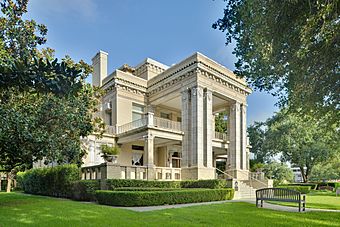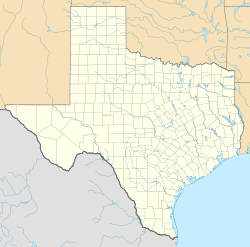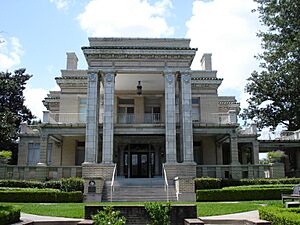Link–Lee House facts for kids
|
Link-Lee House
|
|
 |
|
| Location | 3800 Montrose Houston, Texas |
|---|---|
| Built | 1912 |
| NRHP reference No. | 00000751 |
Quick facts for kids Significant dates |
|
| Added to NRHP | September 11, 2000 |
The Link–Lee House is a big, old house in Houston, Texas. Today, it's used as the main office for the University of St. Thomas. This special house was added to the list of important historic places in 2000. It was also named a Recorded Texas Historic Landmark in 2001, meaning it's a very important part of Texas history.
Contents
Discover the Link-Lee House History
The Link–Lee House gets its name from its first owners, John Wiley Link and Thomas Peter Lee. You can find this house at the corner of Montrose Boulevard and West Alabama Street. It's now part of the University of St. Thomas campus in Houston. The building has a grand entrance with tall columns, called a portico. It's made of brick with special clay decorations called terra cotta.
Meet the Link Family
John Wiley Link (1866–1933) was born in Gallatin, Texas. He studied law at Baylor University and became a lawyer in 1888. He worked as a lawyer in Amarillo and Orange. In Orange, he was even elected mayor in 1905.
Mr. Link became very rich through the lumber business and banking in east Texas. In 1910, he moved to Houston. He believed Houston would grow a lot because of its new oil industry. He helped start The American General Insurance Company and was the second president of The Dr. Pepper Company. He also created the Houston Land Corporation. He bought many properties, about 250 acres, near Houston.
He set aside some land to build the first part of Montrose Boulevard. This was the main street for his fancy new neighborhood. He planned his own house on Block 41, right on Montrose Boulevard and West Alabama Street. The famous architects Sanguinet, Staats, and Barnes designed his home. It was built in 1912 by the Young Contracting Company.
Meet the Lee Family
Thomas Peter Lee (born March 19, 1871) started working at just sixteen years old. He began as an oil field worker in West Virginia and Ohio. In 1903, he moved to Saratoga, Texas, to work for the Texas Company. Later, in 1914, he helped start Farmers Petroleum Company and became its president.
Mr. Lee bought the Link-Lee House at the end of 1916 for $90,000. At that time, the Link–Lee House was the biggest single-family home in Houston. It had more than 10,000 square feet! The main floor had a breakfast room, a formal dining room, and a music room. It also had a full basement. On the second floor, there were five bedrooms, each with its own bathroom. The third floor even had a ballroom for parties!
After Mr. Lee passed away, his family owned the house until July 9, 1940. Then, his family, including Mrs. Essie N. Lee, sold the house to the University of St. Thomas for $120,000. The family wanted the college to pay $6,000 in cash. The remaining $114,000 was given as a donation. This donation was guaranteed by a special note to the William M. Rice Institute in Houston.
The Link-Lee House and University of St. Thomas
The house, now called the Link-Lee Mansion, and the land around it became the main building for the University of St. Thomas. The university is still there today! At first, the entire university was in this one building. Now, it holds the main offices for the university leaders.
The mansion still looks mostly the same, but it has been changed a bit inside. This was done to make space for offices. These offices include the president's office, the vice president for Academic Affairs, and the Dean of Arts and Sciences.
The outdoor areas around the mansion were once used for a fun Halloween party called Neewollah every October. This tradition stopped in 2006. That's when the Edward P. White Memorial Plaza was built. This plaza has a large granite stone and a fountain. It was the last design by the famous architect Philip Johnson.
There are plans for the future to move the offices out of the mansion. The goal is to make the house look exactly like it did in 1912. These plans can only happen if the university buys some nearby properties first.




